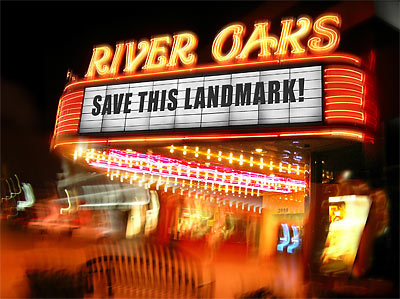
Disposing of older buildings used to be so simple. It’s tougher now, but it’s not impossible. You’ll just need to use some new techniques. If the buildings you want to demolish have a high enough profile, you’ll also need a good PR consultant who can help you with strategy.
For a while, it looked like Weingarten Realty might have some trouble tearing down its historic River Oaks Shopping Center, River Oaks Theater, and Alabama Bookstop (which used to be the Alabama Theater—back in the day when people watched movies instead of reading so much). When rumors first began to circulate, there was the big hullabaloo about the River Oaks Theater, and all those online petitions.
But since then, not so much. Weingarten clearly has its winning gameplan mapped out. How did they do it? How do you tear down an immensely popular older building in Houston today, and do it right?
The technique you need involves outrage bait. What’s that? Read on, after the jump!
***
Here—generalized, so any would-be redeveloper can take advantage of the technique—is the handy eight-step “outrage bait” strategy for demolishing any remaining Houston landmarks:
- Make sure you have several beloved older buildings that could be considered “in danger”—ideally they’ll be near each other. (If you’re working with just one, your strategy will be much different: We recommend the tried-and-true Saturday Morning Secret and Sudden Demolition technique.) At the same time, figure out which of those buildings is the popular favorite, and whose demolition would cause the greatest public outcry. (All right, “outcry” is a little strong. This is Houston.)
- Get the worst news out first. Let word leak out that you’re thinking of demolishing the most popular building, but that the other buildings are endangered too. Try to make sure that preservationists think of the buildings as a group, but do what you can to make sure news headlines focus just on the most popular one.
- Annoy those “concerned citizens” by not answering questions and issuing non-denial denials. Get those sentimental fools all worked up. Bait the outrage!
- Wait. A long time.
- Here’s where you switch the bait. It’s tricky, though. You’ll need to do two things in close sequence, maybe a week or two apart:
 Release images of a new development you have planned for the site that has the lowest public profile. Make sure the drawings are vague, that you highlight how similar the new building will be to what it’s replacing (especially in its “style”) and that they include indications that you’ll be providing some popular amenity, like another one of those damn bookstores. Time the release so that the images appear right before the weekend, so there’s little opportunity for a quick public “response” for at least a few days. Make sure current tenants of this building are out within about a month, so you can demolish it soon after. At the same time, declare that there are “no current plans” to demolish the most popular building.
Release images of a new development you have planned for the site that has the lowest public profile. Make sure the drawings are vague, that you highlight how similar the new building will be to what it’s replacing (especially in its “style”) and that they include indications that you’ll be providing some popular amenity, like another one of those damn bookstores. Time the release so that the images appear right before the weekend, so there’s little opportunity for a quick public “response” for at least a few days. Make sure current tenants of this building are out within about a month, so you can demolish it soon after. At the same time, declare that there are “no current plans” to demolish the most popular building.- Next, allow various hints of hope that the more-popular building could be preserved. This might mean allowing a meaningless landmark designation to go forward, or meeting with an architecturally inclined City Council member and pretending you’re interested in the heroic Plan To Save The Endangered Landmark he sketches out on a napkin. Encourage him to tell the story to the press!
- With much of the public distracted by misleading headlines that their Beloved Favorite Building will probably be saved, you won’t have much problem demolishing and then redeveloping the property that has the lower public profile. Here’s an important point: Make sure the replacement is just cheesy, monstrous, inappropriate, and popular enough that it annoys the hell out of architects and design snobs, but doesn’t really bother anyone else. The goal is to dishearten the self-appointed design elites so much that they realize trying to protect the remaining buildings would be futile. They’ll hate even driving by, and they’ll realize the neighborhood has now changed so much that preserving the popular building would be pointless and only lend an air of undeserved authenticity to the new development. This will also drive a wedge between the design elites and the preservationists, who won’t really understand why those architects think the cause is lost when the popular building is still standing but “endangered.” It will also force a split between the design snobs and the general public of eager petition-signers, who wanted to save the most popular building mostly because it was “old” and they could remember it from when they were younger.
- The rest is easy. Eventually, after you’ve completely transformed the neighborhood with the new development (which you should now expand if that’s possible), the architecture snobs will slowly come out of the woodwork and grudgingly allow themselves to be seen shopping there. They’ll become your new allies, and will try to convince would-be preservationists that saving the
River Oaks Theater(oops!) popular landmark isn’t worth it now because the area has changed so much that the building isn’t at all what it used to be and doesn’t even fit in anymore. You should still diss these designer kooks, though, by throwing some bone to the preservationists, driving a final wedge between their two contingents: the sentimentalists and the knee-jerk diehards. Announce that you will be preserving some dumb detail of the popular building for your new highrise—like the sign, maybe, or the facade. The sentimentalists, which will always be the larger group, will eat this up, while the diehards will just . . . well, rather die. - Bring on the demo crews. Redevelop if you must, but by this point you could even scrape the site and flip it. By the time you get to the last building in the bunch, no one will even try to stop you.
- Theater safe as Weingarten plans $15M redevelopment at River Oaks Shopping Center [Houston Business Journal]
- First steps taken to preserve River Oaks theaters [Houston Chronicle]
Photo: Documentary Alliance, via arch-ive.org. Rendering: Weingarten Realty Investors.




